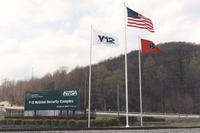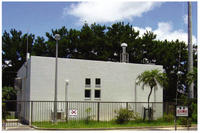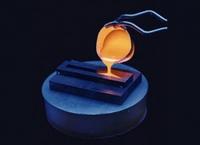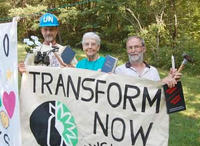-
Idaho debating nuclear waste storage
For two decades, the Yucca mountain nuclear waste repository in Nevada was viewed as a long-term solution to the growing problem of radioactive waste generated by the 104 active nuclear power generation plants in the United States. One of the Obama administration’s first acts was to “defund” the project, in effect outing an end to it. States such as Texas, New Mexico, and North Carolina have fashioned their own interim solution to the problem of nuclear waste storage, and the governor of Idaho wants his state to follow these states’ example.
-
-
Part Three: Bechtel and the Y-12 security breach
With an annual security budget of $150 million, the Y-12 Nuclear Complex at Oakridge, Tennessee, prided itself on its high-tech security system built to protect more than 179 tons of uranium. After Sister Megan Rice, age 82, and two confederates, both senior citizens, too — the three were armed with nothing but wire cutters and flashlights — broke into the Y-12 facility on 28 July 2012, one security guard was fired. Numerous investigations and reports, however, show that last July’s incident was but one in a series of security failures and breaches at nuclear sites under the supervision of the National Nuclear Security Administration (NNSA). In May, Sister Rice and her aging collaborators will stand trial. Bechtel, a major contractor sharing responsibility for the documented security lapses at Y-12, has just received a federal nuclear plant security contract worth more than $22 billion.
-
-
Thorium holds promise of safer, cleaner nuclear power
Thorium as nuclear fuels has drawbacks, but its main advantage includes generating far less toxic residue. The majority of the mineral is used during the fission process, and it can burn existing stockpiles of plutonium and hazardous waste, saving the need to transport it and bury the waste in concrete. If thorium becomes available as a source of energy in the future, the world will rely less on coal and gas, and wind turbines will become a thing of the past. The risk of a global energy crunch will decrease considerably.
-
-
U.K. revises nuke emergency plans post-Fukushima
The Sizewell nuclear power station in Suffolk, England, was decommissioned in 2006, but after the 2011 Fukushima disaster, the Suffolk authorities thought there was a need to upgrade the emergency plans for the people living around the plant. There are disagreements, however, over the radius of the emergency zone around the plant, and how many people should be included i evacuation plans and given potassium iodide tablets in the event of a radiation leak.
-
-
Tiny helpers: Atom-thick flakes help clean up radioactive waste, fracking sites

Graphene oxide has a remarkable ability quickly to remove radioactive material from contaminated water. Researchers determined that microscopic, atom-thick flakes of graphene oxide bind quickly to natural and human-made radionuclides and condense them into solids. The discovery could be a boon in the cleanup of contaminated sites like the Fukushima nuclear plants, and it could also cut the cost of hydraulic fracturing (“fracking”) for oil and gas recovery and help reboot American mining of rare earth metals.
-
-
Airborne pods tracing nuclear bomb’s origins
If a nuclear device were to unexpectedly detonate anywhere on Earth, the ensuing effort to find out who made the weapon probably would be led by aircraft rapidly collecting airborne radioactive particles for analysis; relatively inexpensive UAVs, equipped with radiation sensors and specialized debris-samplers, could fly right down the throat of telltale radiation over a broad range of altitudes without exposing a human crew to hazards
-
-
U.S. cuts budget for nuclear monitoring at foreign ports
In 2003 the United States decided to install radiation detection equipment in 100 large ports around the world, and train local personnel in using the equipment, so that ship containers could be scanned for nuclear material before the ship left for the United States; so far, equipment has been deployed in forty-two ports; after GAO criticism of the quality of the scanning equipment and of lack of coordination between two similar container scanning programs, the National Nuclear Security Administration’s 2013 budget will be cut by 85 percent, and further installations will be canceled
-
-
New, quick way to ID people exposed to dirty bomb, radioactive radiation
Research conducted by scientists from the Berkeley Lab could lead to a blood test that detects if a person has been exposed to radiation, measures their dose, and separates people suffering from inflammation injuries — all in a matter of hours
-
-
Tetrapod robot developed for investigative, recovery work inside post-accident nuclear plants
Toshiba has developed a tetrapod robot able to carry out investigative and recovery work in locations which are too risky for people to enter; the multiple joints of its legs are controlled by a dedicated movement algorithm which enables the robot to walk on uneven surfaces, avoid obstacles, and climb stairs, securing access into areas which are challenging to be reached by wheeled robots or crawlers
-
-
Powerful debugging program to help U.S. nuclear deterrence
Lawrence Livermore National Laboratory (LLNL) researchers have used the Stack Trace Analysis Tool (STAT), a highly scalable, lightweight tool to debug a program running more than one million MPI processes on the IBM Blue Gene/Q (BGQ)-based Sequoia supercomputer; LLNL plans to use Sequoia’s impressive computational capability to advance understanding of fundamental physics and engineering questions that arise in the National Nuclear Security Administration’s (NNSA) program to ensure the safety, security, and effectiveness of the U.S. nuclear deterrent without testing
-
-
Y-12 Nuclear Complex’s uranium processing facility to be redesigned

Weeks after the inadequacy of security measures at the Y-12 Nuclear Complex came to light — an 82-year old nun and her two senior citizen colleagues eluded the facility’s fences and security to spend a few hours on the site’s grounds and spray-paint anti-nuclear slogans on its walls – criticism is directed at the design shortcomings of a new uranium processing facility; among other things, the roof of the new facility will have to be raised by thirteen feet because the designers did not take into account the size of the equipment the new facility will house
-
-
Two suspected 2010 North Korea nuclear “tests” probably never happened: study

It is generally accepted that North Korea has carried out at least two nuclear test explosions, in 2006 and 2009, with the second test — thought to be in the range of about two to four kilotons — was five times more powerful than the first; this spring, a Swedish scientist sparked international concern when he said that radioactive particles detected in 2010 showed North Korea had set off at least two small nuclear blasts that year; now, a new paper says the tests likely never took place — or that if they did, they were too tiny to have any military significance
-
-
Netanyahu cancels security cabinet meeting on Iran after leaks

Israel’s prime minister, Benjamin Netanyahu, scheduled a 2-day marathon meeting of Israel’s security cabinet for Tuesday and Wednesday, with an 8-hour session planned for each day; the 2-day meeting was called for a thorough and comprehensive – and probably decisive — discussion of Iran’s nuclear weapons program and what should Israel do about it; the speakers on Tuesday included the directors of Israel’s military and civilian intelligence agencies; early Wednesday, Netanyahu abruptly canceled the meeting’s second session because of leaks from Tuesday top-secret meeting session appeared in the Israeli press
-
-
Glass offers a better way of storing U.K. nuclear waste

Researchers have shown, for the first time, that a method of storing nuclear waste normally used only for High Level Waste (HLW) could provide a safer, more efficient, and potentially cheaper solution for the storage and ultimate disposal of Intermediate Level Waste (ILW)
-
-
Invasion at “Fort Knox of Uranium” raises security concerns

The Y-12 National Security Complex in Oak Ridge, Tennessee, is regarded asthe Fort Knox of Uranium, so the fact that three anti-nuclear activists, one of them an 82-year old nun, were able to breach the high-security complex’s protective fences is not reassuring; that they did so using nothing more than bolt cutters, after announcing their arrival from half-a-mile away, and that they could stay, undetected, in a highly secure area on the nuclear complex’s ground for two hours, is even more worrisome
-
- All
- Regional
- Water
- Biometrics
- Borders/Immig
- Business
- Cybersecurity
- Detection
- Disasters
- Government
- Infrastructure
- International
- Public health
- Public Safety
- Communication interoperabillity
- Emergency services
- Emergency medical services
- Fire
- First response
- IEDs
- Law Enforcement
- Law Enforcement Technology
- Military technology
- Nonlethal weapons
- Nuclear weapons
- Personal protection equipment
- Police
- Notification /alert systems
- Situational awareness
- Weapons systems
- Sci-Tech
- Sector Reports
- Surveillance
- Transportation
Advertising & Marketing: advertise@newswirepubs.com
Editorial: editor@newswirepubs.com
General: info@newswirepubs.com
2010-2011 © News Wire Publications, LLC News Wire Publications, LLC
220 Old Country Road | Suite 200 | Mineola | New York | 11501
Permissions and Policies
Editorial: editor@newswirepubs.com
General: info@newswirepubs.com
2010-2011 © News Wire Publications, LLC News Wire Publications, LLC
220 Old Country Road | Suite 200 | Mineola | New York | 11501
Permissions and Policies
